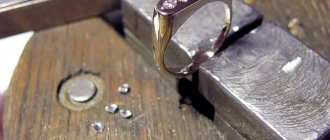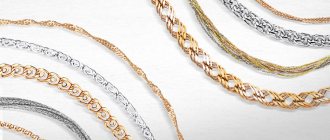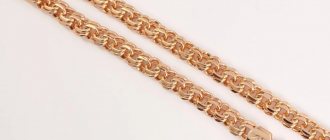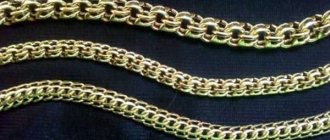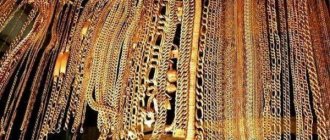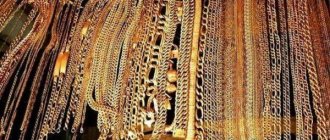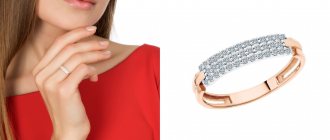A chain is the most versatile and functional product, which, thanks to the skill of specialists, has become a full-fledged piece of jewelry. It is worn as an independent accessory, complemented with a pendant, a body icon or a cross.
Now jewelry manufacturers offer us a huge number of chains: short and elongated, wide and narrow, classic and decorative, men's and women's, gold and silver, not to mention dozens of different types of weaving. How to choose a chain that is right for you? We invite you to figure this out together.
Chain weaving technologies
Chains are made in several ways - by hand, machine knitting or stamping.
Machine weaving is an automated technology using special equipment. The use of machines allows you to create jewelry with links up to 0.2 mm thick.
Despite the latest technologies, some types of weaving can only be done by hand. And here you can’t do without specialists—chain tyers. The minimum weight of a hand-woven chain is about 6 grams, and its quality largely depends on the skill of the jeweler.
This is really painstaking and time-consuming work. First you need to stretch the gold or silver wire, wind it on the prepared base and cut the resulting spiral into rings of the same size. The chain maker manually fastens the links using pliers, “linking” the pattern, which involves the type of weaving. To prevent the rings from falling apart, all the links are soldered. The resulting chain is clamped between special shafts so that the links become flat.
Stamped chains are made from ready-made links - stamps. At the same time, they are not soldered together, but threaded into each other. As a rule, such jewelry is less durable, easily twisted and deformed.
How to do it
The technology for weaving a chain in this style is as follows.
The gold spiral needs to be separated and cut into links so that one link is shaped like a spiral of three curls. Then the links need to be woven perpendicular to each other, while compressing them. After this, turn the product and weave another link. Assemble the links in this way until the product reaches the desired length. Then the process of soldering the links begins. There are several ways to do this:
1. The first is to solder each link separately. Solder is prepared separately into thin plates and then cut into squares. 2. In the second method, chopped solder is laid out and dipped in flux, and then melted with a torch. 3. The third method is mainly used by professionals, since specific skills are required. Solder is prepared in the form of wire. It is brought to the soldering site and parts of the product are soldered.
Solid or hollow: what's the difference?
All chains, regardless of the type of weaving, are divided into solid and hollow.
A distinctive feature of hollow chains is the combination of volume and lightness. The wire from which the decoration is woven is hollow inside, so despite the external thickness of the links, hollow chains have little weight. Most often they are made using complex decorative types of weaving and look quite solid. The advantage of such chains is their affordable price, which is determined by the weight of the product.
Solid chains are much heavier than hollow ones, which affects the cost of the jewelry. However, they are very comfortable for everyday wear, resistant to deformation and external influences and therefore durable. If the links are damaged, a specialist can easily solder the product and restore its original appearance.
Types of chain weaving
There are three basic technologies for knitting chains: “Anchor”, “Pantsirnaya” and “Bismarck”. Over time, they received so many variations that today there are more than 50 types of weaving: from the simplest to the most intricate with links of a complex configuration. Each weave has a special name and can be made in either gold or silver.
It’s easy to guess that “Anchor” weaving got its name due to its resemblance to the weaving of a real anchor chain. It is simple and uncomplicated. In the classic version of weaving, each link has an oval shape.
Links can consist of either one or two “rings”. Therefore, the “Double Anchor” technology is also distinguished.
An "anchor" weave with round shaped links is known as "Rollo". At one time, this type of knitting became popular thanks to the fashion house Chopard, so it has a second name - “Chopard”.
The Garibaldi weave is very similar to Rollo. The links of these chains have a round forked shape. It is believed that the knitting was named in honor of the spouses Giuseppe and Anita Garibaldi - folk heroes of the liberation movement of Italy, who were very friendly and shared each other’s views.
Fantasy types of “Anchor” weaving also include “Aurora” and “Hawaiian”.
“Shell” technology has become the basis for creating various types of decorative weaving. Its distinctive feature is that the flat links, polished on both sides, are not attached perpendicular to each other, but as if in the same plane. The technology, characterized by its high strength, got its name due to its resemblance to chain mail links.
Weaving can be single, double or triple, depending on the number of rings connected. A “shell” knit with diamond-shaped links is called “Diamond” (it can also be double or triple).
“Nonna” is one of the most elegant varieties of armor weaving. Thanks to the diamond edge applied on both sides, such chains shine more in the light. Despite the external sophistication, these jewelry are very durable. Oddly enough, the name of the weave has nothing to do with the woman's name. Nonna is short for the Italian maglia della nonna, which means "grandmother's weave."
An equally spectacular variety of armor knitting is “Figaro”, named after the famous comedy hero Beaumarchais, who was distinguished by his changeable temperament. Just like Figaro, weaving is characterized by “inconstancy” - links of different shapes, short and long, alternate in the chain. The most common combinations are from 1:1 to 1:5. Figaro chains gained popularity thanks to the jewelry house Cartier, and gradually became known as “Cartier”.
Often chains get their names due to the special shape of the links. Thus, the “rings” resembling hearts gave the name to the romantic and delicate weaving “Love”. Thanks to the links twisted into a spiral, the “Snail” weave appeared (it is also called “Paperclip” for the similarity of the “rings” with the stationery of the same name), and the divisions, similar to a beautiful flower, gave the name to the “Rose” chain.
A smooth, snake-like jewelry cord with tightly fitting links is known as a “Snake.” This weaving is comfortable for everyday wear, so it is often used not only in the manufacture of chains, but also bracelets for pendants and charms.
The most popular twisted weaves are the rope-like “Korda” and the “Singapore” shimmering in the sun. Such chains are usually worn by women. These decorations are elegant and at the same time reliable in use.
But “Bismarck” is considered a truly masculine type of weaving in Russia. Named, according to one version, in honor of the first Chancellor of the German Empire, Otto von Bismarck, he is also known as the “Kaiser” or “Cardinal”. This weaving is one of the most complex and is therefore often done by hand. Fantasy knitting consists of links, which in turn consist of several multidirectional “rings”. The weave can be double, triple or quadruple, making it one of the strongest. Due to its thickness and volume, one of the varieties of “Bismarck” was called “Python”.
An undeniable trend is the so-called fantasy chains. These decorations are distinguished by unusual types of weaving, a combination of different shades of metals, multi-layering and the inclusion of decorative “links”. Fantasy chains are more reminiscent of a necklace or beads and are a completely independent decoration that can be worn without a pendant.
Bismarck
The name is known to be similar to the name of Otto von Bismarck, who became famous for his friendly character, reliability and self-efficacy. The jewelers poured all the characteristic designs of the German Chancellor into the lantern. The weaving technique with many rows can look both massive and elegant.
The wickerwork is more beautiful, but it is more flexible and there are many options for wickerwork. Depending on the shape of the welts and the weaving technique, there are 8 other subspecies. And those that are suitable including men’s models and, in particular, women’s models.
Flat bismarck
Classic openwork wickerwork, the sides of the two are twisted in a spiral, pressing against one another.
Podviyny Bismarck
In front of the classic flat lanyard, three turns of a spiral are drawn.
Arabic Bismarck
Two or three rounded edges are joined in pairs in thick wickerwork, which resembles Arabic script.
String
The weaving is smoother, and the edges of the walls flow into one another. With this technique, you can create a beautiful and voluminous lantern with a small vase.
Royal Bismarck
Composite folding wickerwork with spiral-like strips, which are soldered one to the other. The baby comes out beautiful and voluminous, and the little one is smooth and snug.
Python
This type of wicker is also called “American” and “cardinal”. The lanyard is formed from three long rows of openwork weaving, which are connected one after another. The design of the impressions, which can be guessed at least as quickly as the python pieces.
Byzantine wickerwork or “fox tail”
Such wickerwork can be used on massive bracelets and laces. It is cut with a folding visor with straps that are connected in different directions. It’s not surprising that they still call Bismarck’s “younger brother” - a similar, but still different, technique.
Spikelet or Celtic vuzol
Similar to Byzantine, but the sides are straightened to one side and the V-like bow resembles an ear of wheat.
This type of wicker lanyard forms an extremely attractive decoration. If you carelessly save or wear a bismarck, it is almost impossible to get lost.
Which weave to choose?
Of course, first of all it is a matter of taste. However, some types of chains are traditionally classified as women's, men's or universal. Thus, the massive and solid “Bismarck” is most often preferred by representatives of the stronger sex, and the graceful “Nonna”, “Singapore”, “Rose”, “Love” and a number of other varieties are considered truly feminine. A typical unisex weaving option is “Anchor”.
For children, the most optimal are densely knitted chains, for example, “Snake”, as well as jewelry cords made of rubber or leather.
Choosing the chain length
One of the important criteria when choosing a chain is its length. As a rule, the size range consists of models from 40 to 70 cm.
- 40 cm - the chain is worn close to the neck
- 50 cm - the chain is worn at the level of the upper part of the neckline
- 60 cm - the chain is worn at the level of the middle part of the neckline
- 70 cm - the chain is worn at the level of the lower part of the neckline
It is believed that it is better for women to choose chains up to 50 cm, and for men - longer. Still, there are exceptions to every rule, and when purchasing jewelry, you must try it on.
Fantasy Lancers
Fantasy wickerwork is created by a jeweler based on basic designs. Thanks to various decorative elements and techniques for joining stripes, the master weaves together beautiful and precious decoration.
Fancy wickerwork looks impressive on its own, without the addition of pendants or pendants. Let's take a look at the most popular ones.
French braid
It consists of two or three smooth lances braided into a braid. Often made from metals of contrasting colors.
Troyanda
An openwork wickerwork, where the leather structural element is folded into a ring into a small piece, which makes a flower. The lantzyuzhok is even feminine and tall.
Lamellar
Wickerwork made from decorative plates with internal connections.
Perlina abo namisto
Lantsyuzhok, a skin strip that looks like a small bag (namistin) soldered to the base. For greater safety, there is a fastening in the middle of the skin, its ends are sealed with a spring fastener, which compresses the edges and reliably removes them.
Types of chain locks
When purchasing a jewelry chain, pay attention to its lock. Firstly, it must be of high quality, since the safety of the jewelry depends on this “minor” detail. And secondly, the lock should be comfortable so that you can fasten and unfasten it yourself, easily putting any pendants on the chain.
As a rule, the type of lock is selected by the jeweler depending on the weight and type of weaving of the item. More massive chains have reliable carabiners, while elegant, thin models are more suitable for a spring lock. Most often, both types of fasteners allow you to easily put pendants with different eye thicknesses on a chain, so they are approximately equivalent to each other in terms of convenience and reliability.
Methods for preparing lantsyuzhki
There are three methods for preparing lancets and each has its advantages and disadvantages.
- I'll do it by hand.
The jeweler creates the straps by hand and welds them together with a wicker strap. The work is compact and foldable, so the cost of embellishment of manual work is significant. If the connection of the lanks is always hopeless and reliable, then this method is so self-requiring.
- Automated.
Thanks to software control, the automatic (or conveyor) method allows you to produce highly complex designs. The main robot is sculpted by a machine, and the jeweler-operator follows the sculpting programs, which significantly speeds up the time for preparing the product.
Shearing blanks are passed through a special machine and a lance of knitted elements is formed. The job of the jeweler is to cut the wicker into the required pieces and solder the clasps. Using this method, you can create both sophisticated thin laces and fashionable massive embellishments with large lanyards.
- Stamping method.
The technology for preparing lancets is simple and straightforward. Here the ready-made lanks are prepared to be mixed together and sealed with a press. The stamping method significantly speeds up the manufacturing process and reduces waste. Today this method is the most popular. With additional stamping, jewelry and embellishments are made from precious metals. Although the method is less reliable, either manual or automatic weaving, the clear material is resistant to damage and wears for a long time.
Vlassny pants brand ZOLOTA >>
Premium quality jewelry. Buy online from the virobnik. 100% satisfied customers.
Combination of chain with bracelet and pendant
Many of us wear a chain all the time, so we don’t perceive it as decoration. However, we should not forget that this is an accessory that, like any piece of jewelry, requires special combination rules.
The pendant should match the chain in size, weight (about twice as light) and metal color. Thus, a large pendant or cross on a thin chain will look ridiculous, and at the same time, a pendant that is too small will not fit on a massive item.
Be sure to check that the ear of the pendant fits freely through the lock.
In addition to ordinary chains, there are also chain bracelets that are often worn by both women and men. Ideally, the types of weaving of both products should match, but this does not happen often - jewelry can be given as a gift, purchased in different places, or several years apart. Therefore, it is enough that the bracelet and chain match each other in thickness and metal. For example, the “Nonna” chain will look good with a “Rhombus” or “Love” weave bracelet, and the “Bismarck” chain will look good with a wide “Armor” knit.
In any case, if you doubt the compatibility of two decorations, it is better to leave one. As the incomparable Coco Chanel said, “When choosing accessories, take off the last thing you put on.”
Yakirne wattle
The braiding method effectively resembles the anchor lanyard: oval, round or rectangular shaped slats are connected to each other perpendicularly, creating a single thread. I'll go to the sea mooring lanyard for anchor.
Yarn wicker is a classic and never goes out of fashion. However, it is good for both women and men who are more sensitive to the size of the lapel. This type of wicker is divided into several types depending on the shape of the wedge and the joining technique. Let's take a look at the most popular ones.
Suspended anchor
All the same traditional wickerwork, but with some minor additions - wicker oval straps.
Rollo abo Chopard
The weave was named after the Swiss brand of anniversary and decoration, which pioneered the fashion for perfectly round breasts. Rollo is similar to the traditional anchor type, the same type is ring-shaped.
Due to the elegant simplicity and lightness of the design, the roll serves as a harmonious base for a pendant or pendant.
Podviyne rollo or “garibaldi”
A collection of names in honor of the Italian revolutionary friends, activists of the free movement in Italy. The couple was respected by the standard of homeland unity, even though the stinks were always shoulder to shoulder.
The “Garibaldi” wickerwork is divided into two ring-shaped joints, where one has a larger diameter, and the other has a smaller one. A small strap is woven into the middle of a large ring, so the lanyard comes out openwork, but at the same time it is smart and reliable.
Cobra abo giotto
Lightweight type of wicker, which is represented by a miniature rollo with a lamel diameter of less than 5 mm.
Behind its outward appearance, the cobra guesses the little moth. Up to one sling, attach several other slats, jumping over 2-3 slats. This results in a piece of twisted wickerwork that can be worn both as a stand-alone decoration and as a base for a pendant.
Venetian wattle or “box”
They call it Venetian because jewelers first began to work in Venice for a hundred years. Today, one of the most popular types is the wicker lantern.
The four-sided shaped straps effectively form a square box and are reliably sealed using the internal joining technique. Perfect symmetry from whichever side you look!
